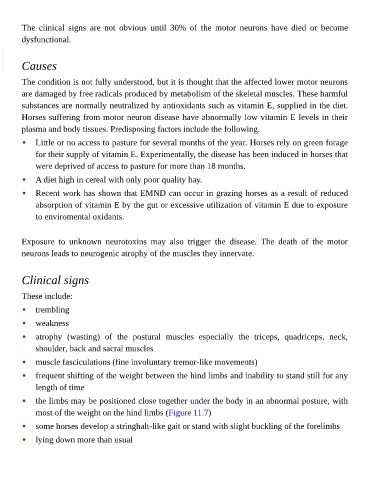Page 493 - The Veterinary Care of the Horse
P. 493
The clinical signs are not obvious until 30% of the motor neurons have died or become
dysfunctional.
VetBooks.ir Causes
The condition is not fully understood, but it is thought that the affected lower motor neurons
are damaged by free radicals produced by metabolism of the skeletal muscles. These harmful
substances are normally neutralized by antioxidants such as vitamin E, supplied in the diet.
Horses suffering from motor neuron disease have abnormally low vitamin E levels in their
plasma and body tissues. Predisposing factors include the following.
• Little or no access to pasture for several months of the year. Horses rely on green forage
for their supply of vitamin E. Experimentally, the disease has been induced in horses that
were deprived of access to pasture for more than 18 months.
• A diet high in cereal with only poor quality hay.
• Recent work has shown that EMND can occur in grazing horses as a result of reduced
absorption of vitamin E by the gut or excessive utilization of vitamin E due to exposure
to enviromental oxidants.
Exposure to unknown neurotoxins may also trigger the disease. The death of the motor
neurons leads to neurogenic atrophy of the muscles they innervate.
Clinical signs
These include:
• trembling
• weakness
• atrophy (wasting) of the postural muscles especially the triceps, quadriceps, neck,
shoulder, back and sacral muscles
• muscle fasciculations (fine involuntary tremor-like movements)
• frequent shifting of the weight between the hind limbs and inability to stand still for any
length of time
• the limbs may be positioned close together under the body in an abnormal posture, with
most of the weight on the hind limbs (Figure 11.7)
• some horses develop a stringhalt-like gait or stand with slight buckling of the forelimbs
• lying down more than usual

